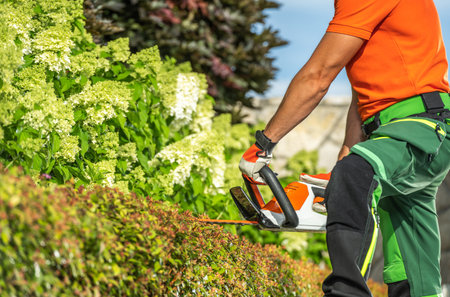Understanding the British Weather and Its Impact on Garden Tools
If youve lived in the UK for any length of time, youll know that our weather is nothing if not unpredictable. One minute, its a fine sunny afternoon; the next, a persistent drizzle sets in that seems to soak into everything. For those of us who take pride in our gardens, this damp and ever-changing climate presents particular challenges when it comes to maintaining garden equipment. Unlike places blessed with long stretches of dry weather, here in Britain we have to contend with moisture that lingers, leading to rust, corrosion, and deterioration of our trusty tools. Whether you’re dealing with metal spades, wooden-handled forks, or electrical lawn mowers, each piece of equipment feels the effect of our soggy seasons. Taking special care isn’t just a suggestion—its essential for keeping your kit in working order. Proper maintenance during wet weather can mean the difference between a tool that lasts decades and one that needs replacing after just a few years. In this article, we’ll explore best practices rooted in generations of experience, ensuring your garden tools are always ready for action, come rain or shine.
2. Essential Pre-Use Checks and Protective Measures
Before heading out into the garden during our famously unpredictable British weather, it pays to carry out a few quick but crucial checks on your equipment. Wet weather brings with it persistent rain and high humidity—conditions that can quietly take their toll on even the sturdiest of tools if we aren’t mindful. A simple routine of inspection, paired with sensible protective measures, goes a long way in extending the life of your gardening kit.
Quick Inspection Checklist
Make it a habit to inspect your tools before and after use, especially during damp spells. Here’s a straightforward checklist you can refer to:
| Check | What to Look For | Why It Matters |
|---|---|---|
| Metal Parts | Rust spots or corrosion | Early detection prevents lasting damage |
| Wooden Handles | Splitting or swelling from moisture | Avoids breakage and ensures safe grip |
| Moving Joints | Stiffness or sticking due to dampness | Keeps pruners and shears working smoothly |
| Electric Cables (if applicable) | Cuts, nicks, or fraying insulation | Prevents dangerous electrical faults in wet conditions |
Sensible Storage Solutions
The classic British shed is more than just a place to hide from the rain—it’s your first line of defence against the elements. If you don’t have one, invest in robust covers or waterproof storage boxes. Make sure all tools are wiped down before storing, as lingering moisture is a surefire route to rust and mildew.
A Few Long-standing Tips from the Allotment Veterans:
- Hang tools up: Keep spades, forks, and rakes off the ground where puddles might form inside sheds or garages.
- Avoid plastic bags: They trap condensation, which can do more harm than good.
- Use silica gel packs: Pop a few in toolboxes to absorb excess moisture—an old trick that still works wonders.
Summary Table: Protective Measures at a Glance
| Measure | Main Benefit |
|---|---|
| Sheds & Covered Storage | Keeps equipment dry and shields from direct rainfall |
| Covers/Tarpaulins | Useful for larger items left outside temporarily |
| Towel-down Routine | Reduces risk of rust straight after use in wet weather |
| Elevated Shelving/Hooks | Prevents contact with damp floors; allows air circulation |
If you get into these habits, you’ll find your trusty tools will serve you faithfully season after season—even when the heavens open without warning.

3. Cleaning and Drying Best Practices After Use
After a long, damp day in the garden, it’s all too tempting to simply stow away your tools and call it a night. However, the British weather is notoriously unforgiving on neglected equipment, and a little care goes a long way. Begin by removing muck, grass clippings, and debris from all surfaces—pay special attention to joints and moving parts where mud tends to lodge. Use a stiff brush or an old rag for stubborn dirt, and if needed, rinse with water before drying. Always dry your equipment thoroughly; moisture left behind is an open invitation for rust and corrosion, especially with our persistent rain and drizzle. Lay tools out in a well-ventilated shed or under cover, allowing air to circulate freely. For best results, avoid leaving them on cold concrete floors where condensation can accumulate overnight. Once dry, store your equipment properly—hang hand tools or stand them upright so that water drains away rather than pooling. This routine not only prolongs the life of your kit but also ensures that everything is ready and safe for use next time the sun peeks out from behind the clouds.
4. Maintenance Routines for Longevity
When it comes to ensuring your garden equipment stands the test of time through our famously damp British seasons, regular maintenance is absolutely essential. Over the years, Ive found that a bit of diligence goes a long way, and establishing a set routine makes all the difference come rain or shine. Below are some trusted practices for keeping your tools in top nick, no matter how wet the weather gets.
Oiling: The Unsung Hero
After each use, particularly during prolonged periods of rain, it’s wise to thoroughly dry your tools and apply a light coat of oil to any metal parts. This helps ward off rust and keeps moving joints operating smoothly. For most hand tools, a dab of general-purpose lubricating oil does wonders. For larger kit like lawnmowers or strimmers, refer to the manufacturer’s guidance on which oils are best.
Sharpening: Cutting Down on Effort
Dull blades don’t just make work harder—they can also damage plants and strain your muscles. A regular sharpening schedule ensures your secateurs, shears, and mower blades stay effective. Aim for a quick check after every few uses, especially if you’ve been working in soggy beds where mud can quickly blunt edges. Here’s a simple guide I’ve used over the years:
| Tool | Sharpening Frequency | Recommended Method |
|---|---|---|
| Secateurs & Shears | Every 2-3 weeks in wet months | Whetstone or diamond file |
| Lawnmower Blades | Monthly or as needed | Bench grinder or file (remove blade first) |
| Spades & Hoes | Once per season or when dull | Bastard file or sharpening stone |
Servicing: Prevention Is Better Than Cure
An annual service is something I never skip—especially before and after the wettest parts of the year. For petrol-powered tools, this means checking spark plugs, air filters, and fuel lines; electric kit should have leads inspected for wear and switches tested for safe operation. If you’re unsure about tackling these yourself, a local repair shop will usually offer seasonal servicing at reasonable rates.
A Little Regular Care Goes a Long Way
The British weather may be unpredictable, but with these routines in place, your garden tools can last for generations. Remember: clean after use, oil regularly, keep blades sharp, and book in that annual service—you’ll thank yourself next season when everything works as it should.
5. Safe Storage Solutions for Wet Conditions
When it comes to protecting your garden equipment during the notoriously damp British months, proper storage becomes more than just a matter of tidiness—it’s an essential practice. A well-organised shed is your first line of defence against rust and rot, especially when the weather refuses to play nice. To start with, make sure your shed is free from leaks and has adequate ventilation; good airflow will help keep humidity at bay, safeguarding both metal and wooden tools. If you’re short on space, consider installing sturdy racks along the walls. These racks not only keep items off the floor—well away from any puddles or rising damp—but also help you see everything at a glance, making it easier to grab what you need without a fuss.
Hooks are another old-fashioned but highly effective solution that should never be underestimated. Fix them securely into beams or wall studs and hang up spades, forks, and even hoses so they dry out properly between uses. For smaller tools like secateurs or trowels, invest in a few labelled bins or baskets placed on elevated shelves; this keeps them organised and reduces the risk of misplacement. If you’re storing anything with an electrical component—like hedge trimmers—be doubly sure these are kept well above ground level and away from any potential water ingress points.
Don’t forget to sweep out your shed regularly to avoid slippery algae building up on the floor—a hazard for both you and your tools. Finally, if your garden gear has seen a bit too much rain before it makes it back inside, always give it a quick wipe-down before storage. By combining practical organisation with a touch of vigilance, you’ll find your trusty tools last far longer, no matter how many showers come rolling over the horizon.
6. Troubleshooting Common Issues
When it comes to maintaining garden equipment during Britain’s notoriously damp weather, even the most vigilant gardener may encounter a few niggling problems. The perpetual drizzle and high humidity can foster mould, encourage rust, and leave moving parts sticky or stiff. Here are some practical tips—passed down through generations—for tackling these common issues before they become real headaches.
Tackling Mould and Mildew
If you notice a musty smell or fuzzy patches on your tools, you’re likely dealing with mould. Begin by scrubbing the affected surfaces with a stiff brush dipped in soapy water. For stubborn growth, wipe down with a diluted vinegar solution (one part vinegar to two parts water), which is both effective and eco-friendly. Always dry your equipment thoroughly afterwards, as lingering moisture is an open invitation for mould to return.
Combating Rust
Rust is a common foe in Britain’s wet climate. If caught early, surface rust can be removed using fine steel wool or a wire brush. For more persistent spots, try applying a paste of baking soda and water before scrubbing. Once clean, dry the metal completely and rub in a thin layer of oil—vegetable oil works well for most hand tools—to provide a protective barrier against future rusting.
Dealing with Sticky or Stiff Moving Parts
Wet weather can cause hinges, gears, and other moving components to seize up. Disassemble what you safely can and wipe away any dirt or old grease with a rag. Apply a squirt of WD-40 or a drop of light machine oil to the moving parts, then work them back and forth to ensure smooth operation. Remember: over-lubricating can attract more grime, so use sparingly.
A Few Extra Tips from Old Hands
Store all equipment off the ground and away from damp corners—even if it means hanging tools from shed walls or using pallets as makeshift racks. After each use in wet weather, take a moment to give everything a quick wipe-down; it’s the little routines that make the biggest difference over time.
Know When to Seek Help
If despite your best efforts something isn’t working as it should—a power tool won’t start or corrosion seems beyond repair—don’t hesitate to consult your local hardware shop or garden centre for advice. Sometimes there’s no substitute for experience, especially when battling Britain’s famously fickle weather!


